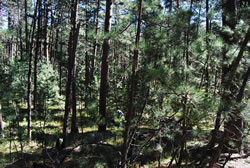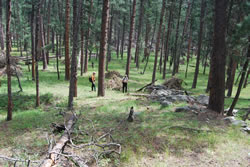
National Fire Plan Success Story
Old Growth Restoration Project at Mount Rushmore Guided by Research Funded by Joint Fire Science Program
Mount Rushmore National Memorial, South Dakota
National Fire Plan - Fuels Reduction
2009


Pre- (top) and post-treatment (bottom) photos of monitoring plot within the restoration unit at Mount Rushmore National Memorial. Pole-sized tree density was reduced by more than 95%.
In fall 2005, researchers began documenting changes in the historical fire regime and forest structure using tree-ring data from the past several centuries. Fire regime is the combination of frequency, seasonality, severity, intensity, and scale of wildland fire across a landscape. The research was to estimate crown fire risk and the effects of potential mitigation measures. The principal investigator on this study was Dr. Peter Brown, director of Rocky Mountain Tree-Ring Research. Data were collected from 1000 trees, snags, stumps, and logs throughout the Memorial. The data showed that from 1600 to 1900, fires burned across the Memorial an average of every 17 years. The last wildland fire to burn through the memorial was 1893.
The current forest contains more small-diameter trees, fewer large trees, and lower canopy base heights than the historical forest. Fire behavior modeling suggests that surface fires would have dominated fire behavior in the pre-settlement forest during both moderate and severe weather conditions, while high-severity crown fire would dominate in the current forest. The abundance of old and large ponderosa pine trees make restoration to historic stand structure within a short time frame more feasible than in most of the Black Hills, and this area could be a valuable reference landscape for Black Hills old-growth forest conditions.
Dr. Brown visited the Memorial in May 2007 and presented his findings to park and fire management staff. He recommended mechanically thinning smaller-diameter trees followed by prescribed fire to reduce litter and duff accumulations. Dr. Brown also suggested that treatments should by initiated in the remnant old-growth stands of the Memorial because they are still in relatively good condition except for the abundant dog-hair. As a direct result of this study and Dr. Brown’s recommendations, the Memorial started a restoration project in the southern section of the Memorial. The project has involved mechanically removing with chainsaw most Ponderosa pine trees 5 inches in diameter and smaller. The material stacked in piles by hand will be burned during the winter when there is snow cover. Approximately 30-acres were thinned in fall 2008 and an additional 25 completed summer 2009. At least two thousand slash piles were created during this project and will be burned over the next couple of winters when snow cover permits.
The Northern Great Plains Fire Ecology Program has established monitoring plots in the restoration area to document changes to the ponderosa pine stands and to assess the success of the treatments. The fire ecologists also hope that these treatments will make the stand more resilient to an ongoing mountain pine beetle outbreak on the forest adjacent to the Memorial.
Contact: Jim McMahill, Fire Management Officer, Northern Great Plains Fire Management Office, (605) 745-1156.